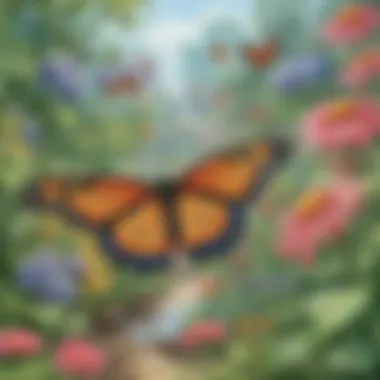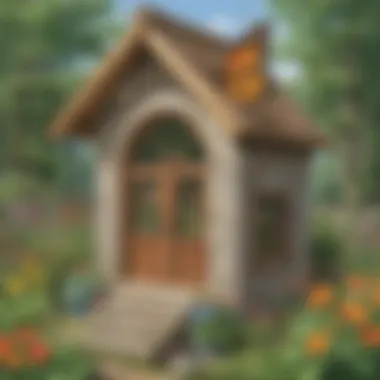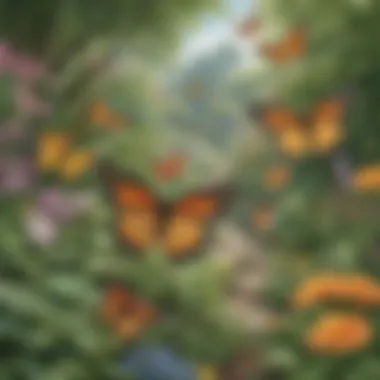Ultimate Guide: How to Create a Butterfly Haven in Your Garden


Science Fun Facts
Curiosity about butterflies often leads to fascinating discoveries. Did you know that butterflies taste with their feet? Yes, it's true! Their taste sensors are located in their legs, allowing them to determine if a plant is suitable for laying eggs or gathering nectar. As you delve into the world of butterflies, you'll encounter more intriguing details that showcase the wonders of these delicate creatures.
Discover the Wonders of Science
Exploring the intricacies of butterfly habitats unveils a realm of scientific marvels. Observation plays a crucial role as you witness the interaction between butterflies and various plant species. Educational videos can further enhance your understanding, illustrating the delicate balance within these ecosystems. By immersing yourself in the science behind butterfly gardens, you embark on a journey of exploration and knowledge acquisition.
Science Quiz Time
Engage in a stimulating quiz to test your knowledge of butterflies and their habitats. From identifying different butterfly species to recognizing plant preferences, each question offers a glimpse into the intricate world of these winged wonders. Challenge yourself with brain teasers that encourage critical thinking and promote a deeper appreciation for the interconnectivity of nature.
Science Experiment Showcase
Unleash your creativity with fun experiments designed to deepen your understanding of butterfly life cycles. Follow step-by-step instructions to create a welcoming environment for butterflies in your garden. Be sure to adhere to safety tips and precautions to ensure a secure and enjoyable experience. Through hands-on exploration, you'll not only raise butterflies but also foster a love for science and the natural world.
Introduction
In the journey of nurturing a butterfly-friendly garden, understanding the pivotal role of these graceful insects is essential. Butterflies, with their delicate wings and intricate lifecycle, serve as vital pollinators in the ecosystem. As we delve into the nuances of creating a haven for these creatures in our outdoor space, we embark on a path of not just personal enrichment but also ecological harmony. The introduction sets the stage for an exploration into the world of butterflies, emphasizing the significance of their presence amidst our flora. By immersing ourselves in the wonders of butterfly conservation, we not only enhance the beauty of our surroundings but also contribute to the preservation of biodiversity.
Wading deeper into this intricate realm reveals the interconnectedness of all living beings. Transforming our gardens into butterfly sanctuaries is not merely a leisurely pursuit but a responsible act of environmental stewardship. Encouraging the proliferation of butterfly populations entails a reverent appreciation of nature's intricacies. As we cultivate landscapes that attract and sustain butterflies, we engage in a symbiotic relationship that transcends mere aesthetics. The introduction paves the way for a comprehensive exploration of how each of us can partake in safeguarding these ethereal beings for generations to come.
Understanding Butterflies
Understanding Butterflies plays a pivotal role in the realm of butterfly gardening. By delving into the intricate world of butterflies, we gain insight into their behavior, preferences, and the vital role they play in our ecosystem. Recognizing the various species and their unique characteristics equips us to provide a conducive environment for these enchanting creatures. Understanding their lifecycles, from egg to caterpillar to chrysalis to butterfly, allows us to appreciate the beauty of their transformation. Through this section, we will explore the significance of comprehending Butterflies for creating a harmonious garden ecosystem.
Lifecycle of Butterflies
Exploring the Lifecycle of Butterflies unravels the magical journey these creatures undergo. From the humble beginnings as eggs laid on host plants to the fascinating metamorphosis inside a chrysalis, witnessing each stage is awe-inspiring. Understanding the distinct phases of development, such as egg, larva, pupa, and adult, sheds light on the intricacies of butterfly life. Observing how these delicate beings navigate each stage with grace and resilience deepens our admiration for their existence.
Importance of Butterflies in Ecosystem


Delving into the Importance of Butterflies in the Ecosystem reveals their indispensable role as pollinators and indicators of environmental health. As pollinators, butterflies aid in plant reproduction, contributing to biodiversity and food production. Their vibrant presence in gardens signifies a thriving ecosystem. By understanding how butterflies serve as bioindicators, we become more attuned to ecological balance. Protecting their habitats becomes not just a choice but a necessity for maintaining a sustainable environment.
Selecting Butterfly-Friendly Plants
In the realm of butterfly gardening, one of the pivotal decisions that sets the foundation for a thriving habitat is selecting butterfly-friendly plants. These botanical selections are not just mere adornments but strategic components in attracting and sustaining butterfly populations in your garden.
The importance of selecting the right plants cannot be overstated. Butterfly-friendly plants act as a magnet for these delicate insects, providing essential nectar for adult butterflies while also serving as host plants for their eggs and caterpillars. The symbiotic relationship between butterflies and specific plant species is a fascinating ecological dance worth observing.
When considering which plants to incorporate, various factors come into play. Firstly, understanding the native butterflies in your region is crucial to select plants that cater to their specific needs. Different butterfly species exhibit preferences for certain flowers, so a diverse selection is key to attracting a range of butterflies. Additionally, opting for plants with staggered blooming periods ensures a continuous food supply throughout the seasons, bolstering butterfly populations.
Moreover, incorporating a mix of nectar-rich flowers and larval host plants is vital for a holistic butterfly garden. Nectar plants such as milkweed, coneflower, and lantana provide sustenance for adult butterflies, while host plants like dill, fennel, and parsley support caterpillars through their growth stages. This diversity not only attracts butterflies but also aids in their reproductive cycle, fostering a sustainable garden ecosystem.
In essence, selecting butterfly-friendly plants is not just about aesthetics but about creating a nourishing environment for these winged wonders. From providing essential nutrients to supporting crucial stages of their life cycle, the plants you choose play a fundamental role in the success of your butterfly garden.
Creating a Butterfly Habitat
In this detailed guide on raising butterflies in your garden, the section of creating a butterfly habitat holds paramount importance. Ensuring a suitable environment for these delicate creatures is not just beneficial, but essential for their survival and flourishing. When establishing a butterfly habitat, several critical elements need consideration. From the selection of butterfly-friendly plants to the design of appropriate shelters, each aspect contributes significantly to attracting and accommodating these beautiful insects.
Building a Butterfly Garden
Choosing the Right Location
When it comes to choosing the right location for your butterfly garden, meticulous planning is key. The location plays a pivotal role in determining the success of attracting butterflies to your outdoor space. Opt for a spot that receives an adequate amount of sunlight and is sheltered from strong winds. Butterflies are particularly drawn to areas with diverse plant life and nectar sources, so aim for a location with a variety of flora. This choice in location not only ensures a thriving butterfly population but also enhances the visual appeal of your garden.
Providing Food Sources
The provision of food sources is a crucial aspect of creating a butterfly-friendly habitat. To attract and sustain butterflies, planting nectar-rich flowers is imperative. Different butterfly species have varying preferences in terms of nectar sources, so incorporating a range of plants will cater to a diverse butterfly population. Additionally, consider planting host plants for butterflies to lay their eggs and nurture their young. By providing ample food sources, you create a thriving ecosystem that supports the complete lifecycle of butterflies.
Including Water Features
Water features add an extra layer of attraction to your butterfly garden. Butterflies, like many other creatures, require access to clean water for various purposes. By integrating water features such as shallow ponds or birdbaths, you not only provide drinking water for butterflies but also create a serene element in your garden. However, it is essential to maintain these water features regularly to prevent the breeding of mosquitoes. Overall, incorporating water elements enriches your butterfly habitat and offers additional delight to both you and your winged visitors.
Butterfly House or Shelter


To further enhance your butterfly-friendly garden, the inclusion of a butterfly house or shelter can serve as a cozy retreat for these delicate insects. Butterflies may seek shelter during inclement weather or at night, making a designated house or shelter a beneficial addition. These shelters can vary from simple structures with perches to more elaborate butterfly houses with specific compartments for different species. Providing resting spots for butterflies not only aids in their protection but also adds a charming touch to your garden aesthetic.
Caring for Butterflies in Your Garden
Caring for butterflies in your garden is a crucial aspect when aiming to create a nurturing environment for these delicate creatures. Maintaining a garden that caters to butterflies involves several key elements that directly impact their well-being and survival. From regular monitoring to specific maintenance practices, there are essential considerations to keep in mind.
One of the primary aspects of caring for butterflies in your garden is continuous monitoring. By regularly observing the behavior of butterflies in your garden, you can gain valuable insights into their presence, habits, and overall health. Monitoring allows you to identify any issues or imbalances in the ecosystem that may be affecting the butterfly population. This careful attention to detail enables you to make informed decisions about necessary interventions to support the butterflies.
Additionally, maintenance plays a vital role in ensuring the vitality of your butterfly garden. Regular upkeep, such as watering plants, removing weeds, and providing essential nutrients, is essential for creating a thriving ecosystem for butterflies. By maintaining a clean and well-balanced garden, you help create a welcoming environment that supports the growth and diversity of butterfly species.
Monitoring and Maintenance
Effective monitoring and maintenance practices are essential for ensuring the health and vibrancy of butterfly populations in your garden. Regular monitoring involves observing the behavior, population dynamics, and environmental conditions that impact butterflies. By tracking these factors, you can respond promptly to any signs of distress or imbalance in the ecosystem.
Furthermore, maintenance activities like watering, fertilizing, and pruning are crucial for sustaining a conducive habitat for butterflies. Providing adequate food sources, resting spots, and shelter are essential components of maintenance that support the overall well-being of butterflies. By incorporating these practices into your routine, you create a hospitable environment that encourages butterflies to thrive and multiply.
In essence, monitoring and maintenance are fundamental pillars of butterfly conservation in your garden. By staying vigilant and proactive in caring for these magnificent creatures, you contribute to the preservation of biodiversity and the beauty of nature in your surroundings.
Avoiding Pesticides
A critical consideration in caring for butterflies in your garden is the avoidance of pesticides. While pesticides are often utilized to control pests and maintain plant health, they can have detrimental effects on butterfly populations. Pesticides may unintentionally harm butterflies at various stages of their life cycle, from larvae to adult stages.
To safeguard butterflies from the harmful impacts of pesticides, adopting alternative pest control methods is imperative. Implementing natural pest deterrents, cultivating pest-resistant plants, and practicing integrated pest management are effective alternatives to chemical pesticides. These eco-friendly practices not only protect butterflies but also promote a healthy and sustainable garden ecosystem.
In closing, avoiding pesticides in your garden is a proactive step towards creating a safe haven for butterflies. By embracing pesticide-free gardening practices, you not only safeguard these enchanting creatures but also contribute to the overall health and balance of your garden's ecosystem.
Attracting Butterflies to Your Garden
The section on attracting butterflies to your garden is a crucial aspect of creating a flourishing butterfly-friendly environment. By understanding how to effectively attract butterflies, you not only enhance the beauty of your garden but also play a key role in supporting these delicate creatures. Butterflies are essential pollinators and indicators of a healthy ecosystem, making their presence in your outdoor space vital.
To attract butterflies to your garden, consider planting a variety of nectar-rich flowers that cater to different butterfly species. By offering a diverse range of food sources, you can attract a wider array of butterflies, adding color and vibrancy to your garden. Additionally, creating sheltered spots for butterflies to rest and lay eggs is essential. Providing suitable host plants for caterpillars to feed on is equally important, as it supports the complete butterfly lifecycle.


By incorporating elements such as butterfly feeders and adding specific features like puddling areas with mud, sand, and rocks, you can further enhance the attractiveness of your garden to butterflies. These thoughtful additions provide essential nutrients and resources that cater to their specific needs. Moreover, maintaining a pesticide-free environment is crucial in attracting and retaining butterflies in your garden, as these chemicals can be harmful to their delicate systems.
Using Butterfly Feeders
When it comes to attracting butterflies, using butterfly feeders can be a strategic way to supplement their diet and increase their presence in your garden. Butterfly feeders are simple devices that offer a solution of water and sugar, mimicking the nectar found in flowers. By placing these feeders strategically around your garden, you can provide a convenient food source for butterflies, especially during periods when flowers are scarce.
Selecting the right type of feeder is essential; opt for ones with bright colors that attract butterflies and make the solution easily accessible to them. Regularly cleaning and replenishing the feeder with fresh solution is important to ensure that butterflies are receiving a clean and ample food source. By incorporating butterfly feeders into your garden, you not only attract more butterflies but also create opportunities for observation and appreciation of these charming insects.
Creating a Butterfly-Friendly Environment
Creating a butterfly-friendly environment goes beyond just planting flowers; it involves thoughtful design and consideration of various elements that cater to the specific needs of butterflies. To enhance the attractiveness of your garden to butterflies, incorporate features such as mud puddles, rotting fruit, and rocks, which provide essential nutrients and resources for butterflies.
Decorative elements like colorful rocks or mosaic stepping stones not only add visual appeal to your garden but also create ideal basking spots for butterflies. Planting a mix of native and non-native plants ensures a diverse range of food sources for different butterfly species, increasing biodiversity in your garden. Avoiding the use of chemical pesticides is imperative, as these substances can harm butterflies at various stages of their lifecycle.
By creating a butterfly-friendly environment in your garden, you establish a sanctuary where these beautiful creatures can thrive, fostering a harmonious coexistence between nature and human-made spaces.
Educating Others About Butterfly Conservation
In the realm of butterfly conservation, educating others plays a paramount role in fostering awareness and appreciation for these enchanting insects. By imparting knowledge about the importance of preserving butterfly habitats and understanding their life cycles, individuals can actively contribute to the conservation efforts. Educating others about butterfly conservation is not merely disseminating information but instilling a sense of responsibility towards protecting these fragile beings. The ripple effect of such education can lead to a community-wide commitment to creating butterfly-friendly environments.
Involving Children in Butterfly Conservation
Children harbor a natural curiosity towards the world around them, making them receptive learners in the realm of butterfly conservation. Engaging children in activities that showcase the beauty and significance of butterflies can spark their interest and empathy towards these creatures. Incorporating hands-on experiences such as planting butterfly-friendly plants, observing caterpillars transform into butterflies, and maintaining butterfly feeders can nurture a sense of stewardship in children. By involving children in butterfly conservation, we are sowing the seeds of environmental consciousness and nurturing a generation that values biodiversity.
Community Engagement
Community engagement forms the cornerstone of successful butterfly conservation initiatives. By fostering a sense of unity and shared responsibility within the community, individuals can work collaboratively towards creating vibrant butterfly habitats. Organizing local events, workshops, and outreach programs can mobilize community members to actively participate in butterfly conservation efforts. Collaboration with schools, local authorities, and environmental organizations can further amplify the impact of community engagement. Through collective action and a shared vision for butterfly conservation, communities can become powerful advocates for preserving these delicate creatures and their habitats.
Conclusion
In the grand tapestry of fostering a butterfly haven in your garden, the conclusion serves as the stitching that binds all preceding sections together, weaving a coherent narrative of harmony and preservation. This ultimate segment encapsulates the significance of the entire discourse on nurturing butterflies within your outdoor realm, underpinned by a symphony of specific elements, benefits, and nuanced considerations essential for the holistic understanding and execution of this noble endeavor.
Delving into the essence of the conclusion, we transcend mere horticultural guidance; we embark on a journey towards ecological stewardship and mindfulness. The guiding beacon that is the conclusion illuminates the way forward, shedding light on the interwoven fabric of sustainable practices, biodiversity conservation, and the intrinsic interconnectedness of all living beings within our shared ecosystem.
As we contemplate the core tenets enshrined in the conclusion, bear in mind the multifaceted benefits that ripple outward from your butterfly sanctuary. Beyond the aesthetic allure of vibrant wings fluttering amidst blooms, consider the vital role these delicate creatures play in pollination, thereby fostering floral fecundity and ensuring the continued proliferation of botanical diversity within your garden sanctuary.
Moreover, the conclusion beckons us to gaze beyond the confines of our immediate surroundings, spurring contemplation on the broader implications of butterfly conservation. By cultivating a haven for these enchanting insects, you not only enrich your personal outdoor space but also contribute to the broader tapestry of environmental preservation, embodying the ethos of responsible stewardship encoded within the DNA of sustainable living.
In essence, the conclusion serves as a fulcrum wherein practical guidance converges with profound ecological ethos. Embrace its message, embody its principles, and watch as your garden metamorphoses into a sanctuary where butterflies dance amidst the flora, a living testament to the harmonious coexistence between humankind and the natural world.







